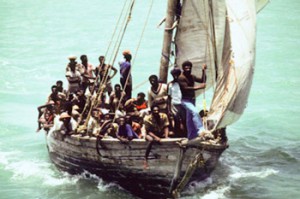WHERE DO WE MIGRATE TO?
Curated by Niels Van Tomme, Director of Arts and Media at Provisions Learning Project and organized with the Center for Art, Design and Visual Culture in Baltimore, Where Do We Migrate To? explores diverging ways in which migration, experiences of displacement and questions of belonging have been addressed by artists in recent years. Calling for an increasingly complex understanding of the human condition, the exhibition demonstrates ways in which the ongoing circulation of people across geopolitical, demographic, and cultural contexts is addressed and questioned through a wide selection of thought-provoking works of art.
Where Do We Migrate To? features the work of nineteen internationally recognized artists and collectives, including: Acconci Studio, Svetlana Boym, Blane De St. Croix, Lara Dhondt, Brendan Fernandes, Claire Fontaine, Nicole Franchy, Andrea Geyer, Isola and Norzi, Kimsooja, Pedro Lasch, Adrian Piper, Raqs Media Collective, Société Réaliste, Julika Rudelius, Xaviera Simmons, Fereshteh Toosi, Philippe Vandenberg, and Eric Van Hove.
The exhibition was displayed March 17 – April 30, 2011 at the Center for Art, Design, and Visual Culture in Baltimore, MD.
It was displayed a second time at the Sheila C. Johnson Design Center at Parsons the New School of Design in New York City, February 3 – April 15, 2012.
A national tour is currently being organized through November 2013.
THE FILM SERIES
An accompanying film and video program, curated by Sonja Simonyi, features a series of programs/screenings by a broad range of international filmmakers and video artists: Chantal Akerman, Herman Asselberghs, Ursula Biemann, Pavel Brailia, Oliver Husain, Isaac Julien, Tanja Ostojic, Egle Rakauskaite, Ben Russell, Ulirch Seidl, Usha Seejarim, Lonnie van Brummelen, and Siebren de Haan.
The program presents a series of audiovisual materials, feature length fiction films, documentaries, as well as experimental videos that addresses the same theme of the exhibition.
While a selection of films engage with migratory practices as central to our understanding of the present-day self in increasingly globalized and multicultural settings, other works investigate the complex historical processes that frame these contemporary conditions.


